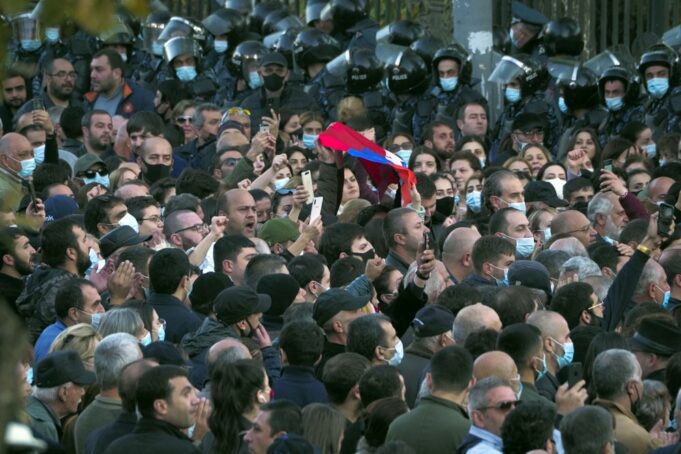Armenian Prime Minister Nikol Pashinyan says he agreed to a Russian-brokered peace deal with Azerbaijan to avoid further losses in the disputed Nagorno-Karabakh region, adding that the continuation of fighting would have resulted in “full collapse.”
“The document secured what we could lose, according to military estimates and other assessments,” Mr. Pashinyan said on Nov. 10. “In a situation when Stepanakert became unprotected, there was a big chance of losing [the main city of] Stepanakert, Martuni, and Askeran if the fighting continued; after that, the defended areas and thousands of soldiers would be surrounded.”
“This would result in a full collapse, and the decision [to sign the ceasefire agreement] was made taking exactly these estimates into consideration,” he added.
Armenia agreed to cease fire with Azerbaijan in Nagorno-Karabakh on Nov. 9, in the face of advancing Azeri troops.
The separatist government of Nagorno-Karabakh said on Nov. 9 it had lost control of the mountainous enclave’s second-largest city of Shusha and that Azerbaijani forces were closing in on Stepanakert.
Armenia made two attempts to regain control over Shusha, Mr. Pashinyan recalled.
“One of the attempts failed. In the second case, an Armenian unit managed to get into the city, and differences in opinions on Shusha’s control were related exactly to the activities of this unit,” he said.
The Russian-brokered ceasefire came into effect overnight on Nov. 9. An exchange of prisoners of war was also scheduled.
Azerbaijan and Armenia had been fighting over Nagorno-Karabakh since September 27.
Russian aircraft carrying peacekeeping forces land in Armenia
Separately on Nov. 10, the Russian Defense Ministry said in a statement that 20 Il-76 aircraft with Russian peacekeepers had landed in the Armenian capital, Yerevan.
Russia had earlier announced that it would be sending peacekeeping forces to Nagorno-Karabakh to monitor the implementation of the ceasefire agreement.
“To carry out the deployment, equipment and weapons have undergone maintenance and an appraisal of technical readiness to move in mountainous areas. After coordinating the routes, Russian peacekeepers will start marching to areas where peacekeeping missions are to be carried out,” the ministry said.
Altogether, 400 military personnel of the 15th Peacekeeping Brigade were deployed with armored personnel carriers, armored vehicles, and communications equipment.
Under the terms of the peace deal, 1,960 Russian troops will replace Armenian forces in Nagorno-Karabakh.
Turkey to monitor ceasefire jointly with Russia: Erdogan
Meanwhile, Turkish President Recep Tayyip Erdogan says Turkey and Russia can use a mechanism similar to the one used in Syria in order to settle the situation in the restive Nagorno-Karabakh.
Mr. Erdogan made the remark during a phone call with his Russian counterpart, President Vladimir Putin, while discussing the situation in Nagorno-Karabakh and Syria.
“The situation in Nagorno-Karabakh demonstrates the necessity of cooperation between Turkey and Russia in settling regional conflicts and crises. President Erdogan noted that it is necessary to adhere to the same spirit of cooperation in the Syrian crisis as well, and here, a similar mechanism can be established,” read a communiqué by the Directorate of Communications of the Turkish President made public after the conversation.
“President Erdogan stated that Turkey together with Russia will also conduct observing and monitoring activity over the ceasefire using a joint center which will be created in a region determined by Azerbaijan in a territory liberated from Armenian occupation,” it added.
Mr. Erdogan had previously declared that both Turkish and Russian peacekeepers would be deployed in the region. The Kremlin had denied that assertion. Karabakh is internationally recognized as part of Azerbaijan, but has been held by ethnic Armenian separatists backed by Yerevan since 1992, when they broke from Azerbaijan in a war that killed some 30,000 people.
While the agreement has outraged people in Armenia, it is expected to raise regional concerns about the transfer of Turkish-backed terrorists from Syria to Karabakh and now the Nakhchivan Autonomous Republic, which is going to be linked to Azerbaijan Republic through a corridor.
Police arrest dozens of protesters at Yerevan rally
Armenian police detained several dozen demonstrators protesting against Mr. Pashinyan’s decision to sign the agreement at a rally in Yerevan on Nov. 11.
Police and special operations units arrested protesters including high-profile opposition figure Gagik Tsarukyan.
An AFP correspondent present at the scene said hundreds of protesters gathered in the city center, shouting “Nikol the traitor.”
“You will not be able to stop the whole country,” Arman Abovyan, a member of the Prosperous Armenia Party shouted to protesters, addressing Pashinyan.
The rally was organized by 17 opposition parties despite a ban imposed on public gatherings while martial law was in place. (PressTV.com)













